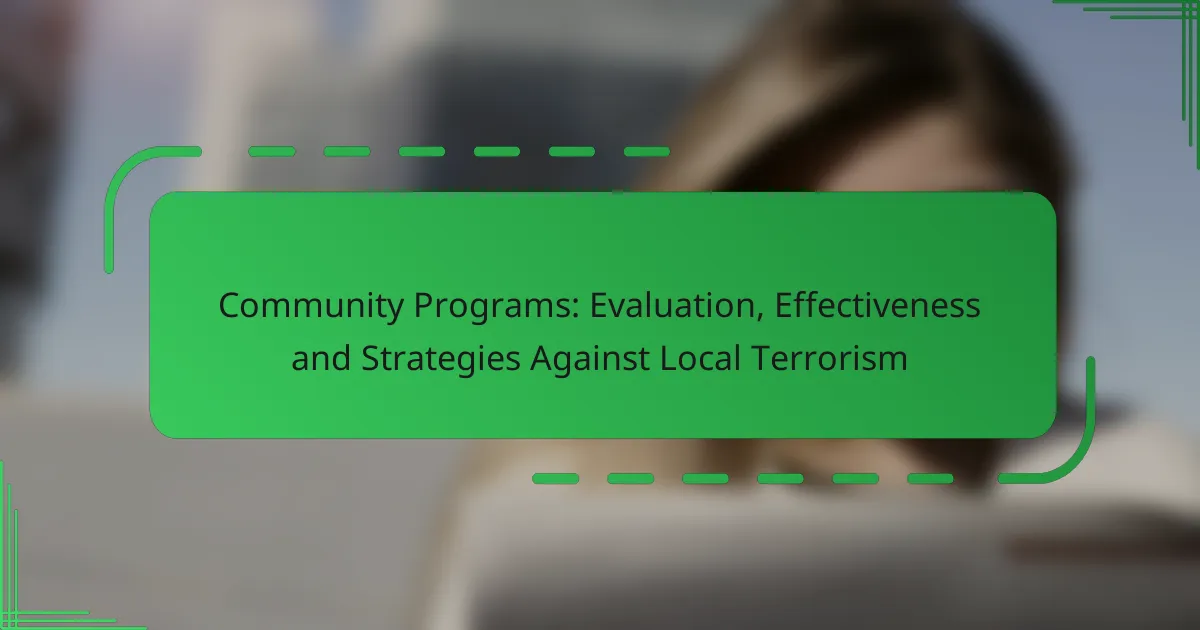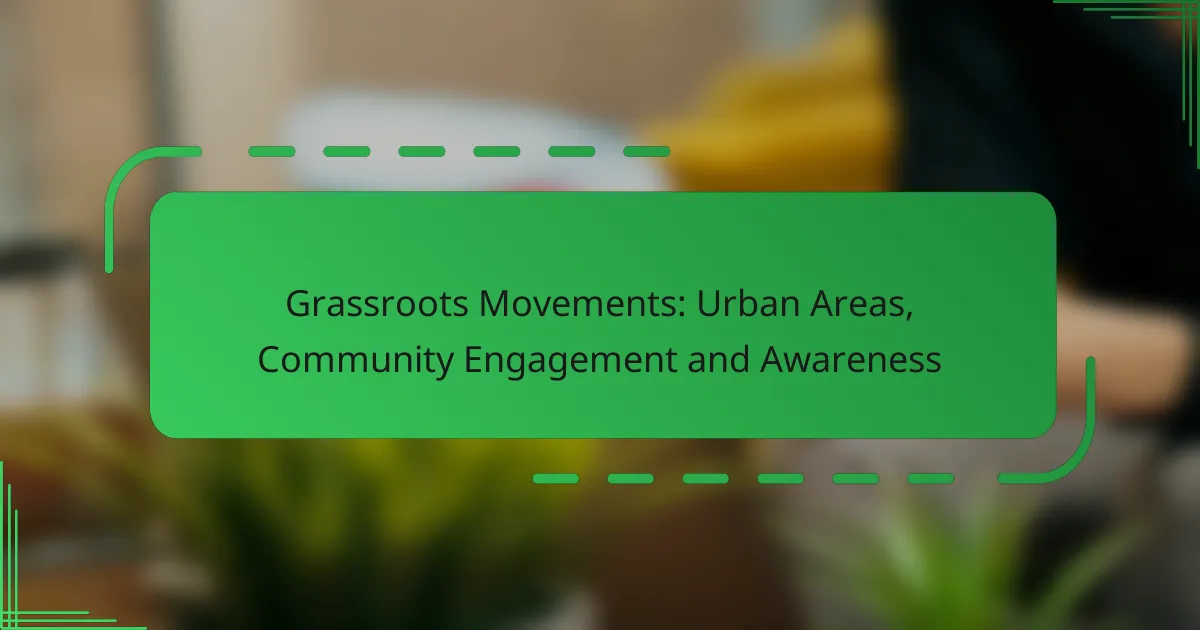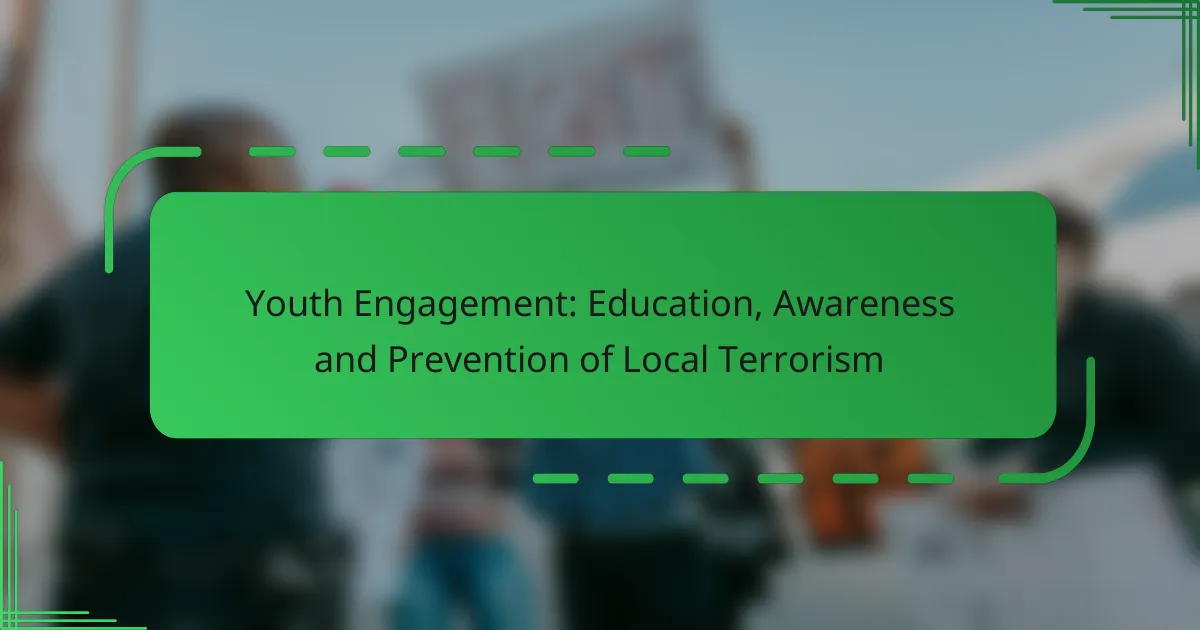Community resilience strategies are essential for enhancing a community’s capacity to prepare for, respond to, and recover from adverse events. By fostering collaboration, resource sharing, and active engagement, these strategies create robust support systems that enable effective recovery and preparedness for future challenges.
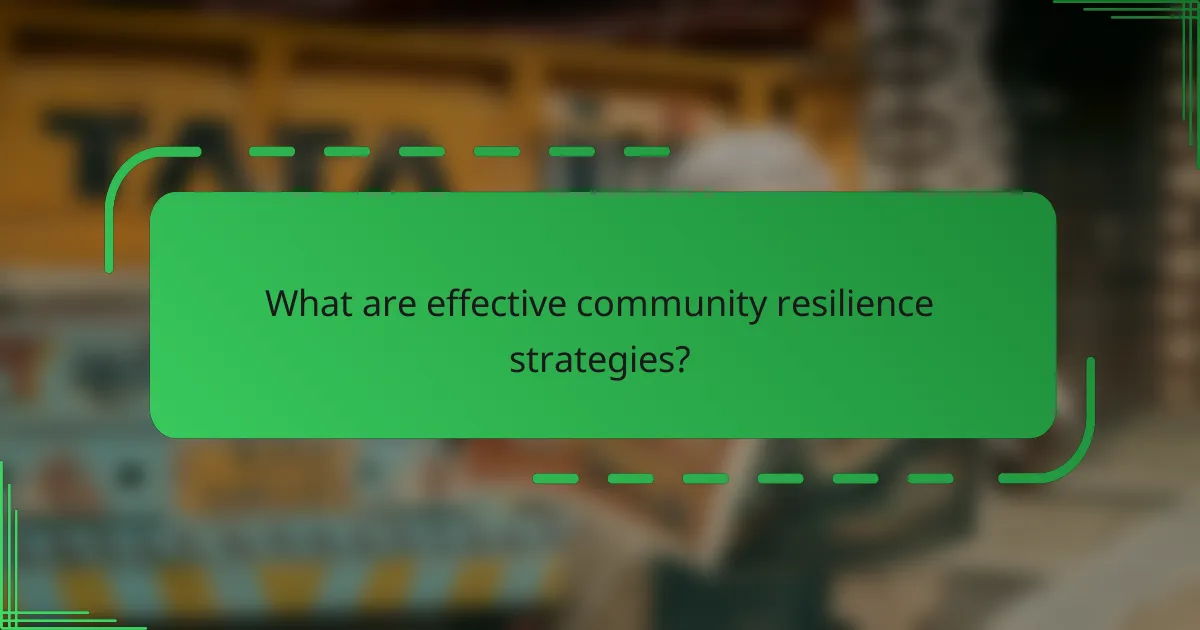
What are effective community resilience strategies?
Effective community resilience strategies are approaches that enhance a community’s ability to prepare for, respond to, and recover from adverse events. These strategies focus on collaboration, resource sharing, training, partnerships, and active community engagement to build a robust support system.
Collaborative planning initiatives
Collaborative planning initiatives involve bringing together various stakeholders, including local governments, businesses, and community organizations, to develop comprehensive resilience plans. These initiatives ensure that diverse perspectives are considered, leading to more effective and inclusive strategies.
Key steps include identifying community vulnerabilities, setting clear goals, and establishing a timeline for implementation. Regular meetings and workshops can facilitate ongoing dialogue and adjustments to the plan as needed.
Resource-sharing networks
Resource-sharing networks enable communities to pool resources, such as equipment, funding, and expertise, to enhance resilience. By collaborating, communities can maximize their assets and minimize redundancy, making it easier to respond to crises.
Examples include shared emergency supplies, joint training sessions, and cooperative funding applications. Establishing clear agreements on resource use and responsibilities is essential to avoid conflicts during emergencies.
Emergency response training programs
Emergency response training programs equip community members with the skills necessary to respond effectively during crises. These programs can cover first aid, disaster response, and evacuation procedures, ensuring that individuals know how to act in emergencies.
Communities should consider offering regular training sessions and simulations to keep skills fresh. Engaging local experts or partnering with organizations like the Red Cross can enhance the quality and reach of these programs.
Local government partnerships
Partnerships with local government agencies are crucial for effective community resilience strategies. These partnerships can facilitate access to funding, resources, and expertise that may not be available at the community level.
Communities should actively engage with local officials to align resilience goals with governmental policies and programs. Regular communication and collaboration can help ensure that community needs are met and that resources are allocated effectively.
Community engagement activities
Community engagement activities foster a sense of ownership and responsibility among residents, which is vital for resilience. These activities can include workshops, town hall meetings, and volunteer opportunities that encourage participation and input from community members.
To maximize involvement, communities should promote these activities through various channels, such as social media, local newsletters, and community boards. Creating a welcoming environment for discussion can help build trust and strengthen community ties.
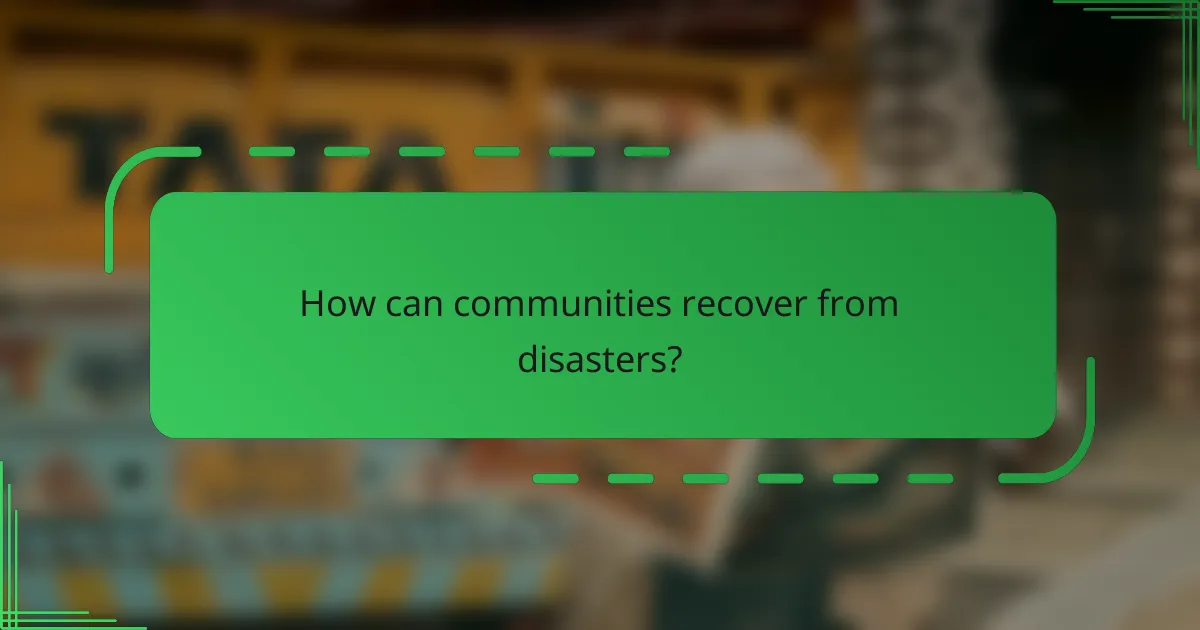
How can communities recover from disasters?
Communities can recover from disasters through coordinated efforts that focus on rebuilding, providing support, and enhancing preparedness. Effective recovery involves planning, psychological support, infrastructure improvements, and financial aid to ensure resilience against future events.
Post-disaster recovery plans
Post-disaster recovery plans are essential for guiding communities through the recovery process. These plans typically outline the steps needed to restore services, rebuild infrastructure, and support residents in the aftermath of a disaster.
Key components of a recovery plan include assessing damage, prioritizing needs, and engaging local stakeholders. Communities should regularly update these plans to reflect lessons learned from past events and ensure they remain relevant.
Psychological support services
Psychological support services play a crucial role in helping individuals cope with the emotional aftermath of disasters. These services can include counseling, support groups, and crisis intervention, aimed at addressing trauma and promoting mental well-being.
Communities should ensure access to trained mental health professionals and create awareness about available resources. Offering workshops and community events can help reduce stigma and encourage individuals to seek help when needed.
Infrastructure rebuilding efforts
Rebuilding infrastructure after a disaster is vital for restoring normalcy and ensuring safety. This process often involves repairing roads, bridges, utilities, and public buildings that were damaged or destroyed.
Communities should prioritize resilient design in rebuilding efforts to withstand future disasters. Engaging local contractors and utilizing sustainable materials can also enhance the recovery process while supporting the local economy.
Financial assistance programs
Financial assistance programs are critical in helping individuals and communities recover from disasters. These programs can include government grants, low-interest loans, and insurance payouts, aimed at alleviating the financial burden of recovery.
Communities should promote awareness of available financial resources and assist residents in navigating application processes. Establishing partnerships with local organizations can help streamline support and ensure that aid reaches those in need effectively.
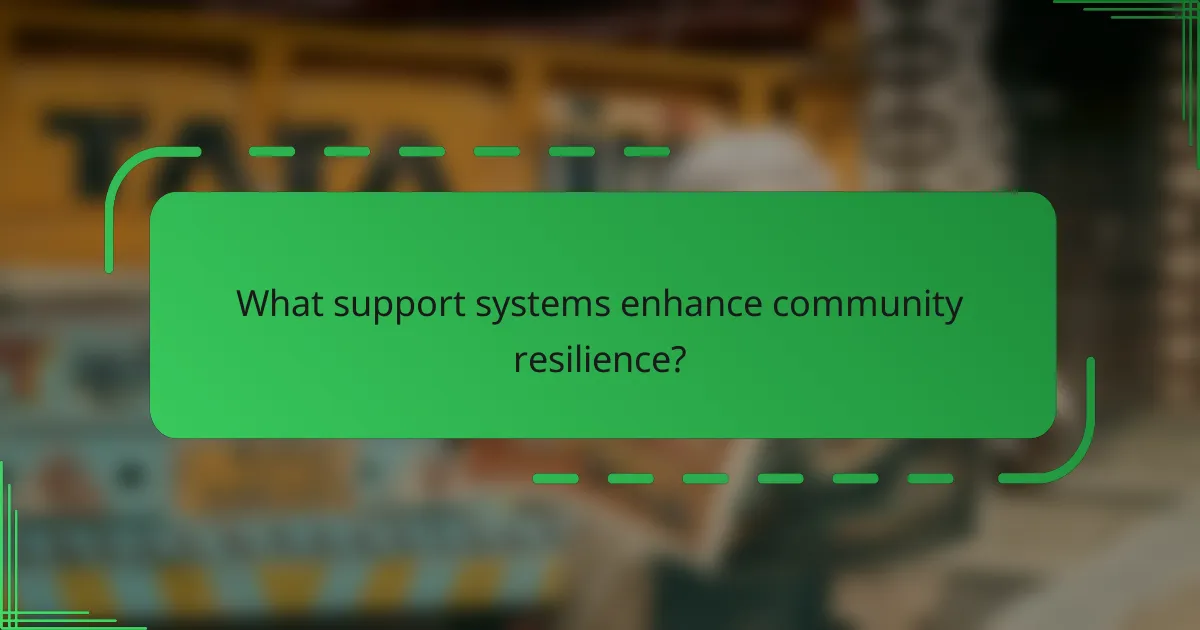
What support systems enhance community resilience?
Support systems that enhance community resilience include social networks, local volunteer organizations, nonprofit collaborations, and public health initiatives. These systems work together to provide resources, foster connections, and facilitate recovery during and after crises.
Social support networks
Social support networks are crucial for community resilience as they provide emotional and practical assistance during challenging times. These networks can include family, friends, neighbors, and community groups that offer help and encouragement.
To strengthen social support networks, communities can organize regular gatherings, workshops, or online forums to foster connections. Encouraging open communication and sharing of resources can significantly enhance the effectiveness of these networks.
Local volunteer organizations
Local volunteer organizations play a vital role in enhancing community resilience by mobilizing individuals to assist during emergencies. These organizations often coordinate volunteers for disaster response, recovery efforts, and ongoing community support.
Communities should actively promote volunteer opportunities and provide training for volunteers to ensure they are prepared to respond effectively. Establishing partnerships with local businesses can also help secure resources and funding for volunteer initiatives.
Nonprofit collaboration
Collaboration among nonprofits can amplify the impact of community resilience efforts by pooling resources and expertise. Nonprofits can work together to address specific needs, such as housing, food security, or mental health services, creating a more comprehensive support system.
Communities should encourage nonprofits to share information and collaborate on projects to avoid duplication of efforts. Regular meetings and joint initiatives can foster a spirit of cooperation and enhance overall community resilience.
Public health initiatives
Public health initiatives are essential for building community resilience, particularly in preparing for and responding to health crises. These initiatives can include vaccination campaigns, health education programs, and emergency preparedness training.
Communities should prioritize public health by promoting awareness of available resources and encouraging participation in health programs. Collaborating with local health departments can help ensure that initiatives are well-coordinated and effectively address community needs.

What role does preparedness play in community resilience?
Preparedness is crucial for enhancing community resilience, as it equips individuals and organizations with the skills and knowledge to respond effectively to emergencies. By fostering a culture of readiness, communities can minimize the impact of disasters and recover more swiftly.
Emergency preparedness training
Emergency preparedness training involves educating community members about potential hazards and response strategies. This training can include first aid, evacuation procedures, and communication protocols. Regular workshops and courses can help ensure that residents are familiar with these essential skills.
Communities should consider partnering with local organizations, such as fire departments or health agencies, to provide comprehensive training programs. Engaging diverse groups, including schools and businesses, can enhance overall community readiness.
Disaster simulation exercises
Disaster simulation exercises are practical drills that allow communities to practice their emergency response plans in real-time scenarios. These exercises can range from tabletop discussions to full-scale drills involving multiple agencies and community members. They help identify gaps in preparedness and improve coordination among responders.
To be effective, simulations should reflect realistic disaster scenarios relevant to the community, such as floods, earthquakes, or wildfires. Regularly scheduled drills can help keep skills sharp and ensure that everyone knows their roles during an actual emergency.
Community resource mapping
Community resource mapping involves identifying and documenting local resources that can be utilized during emergencies, such as shelters, medical facilities, and food supplies. This process helps communities understand their assets and gaps in resources, enabling better planning and response strategies.
Creating a visual map can aid in quickly locating resources during a disaster. Engaging community members in this process ensures that the mapping reflects the needs and capabilities of the entire population, fostering a sense of ownership and collaboration in preparedness efforts.
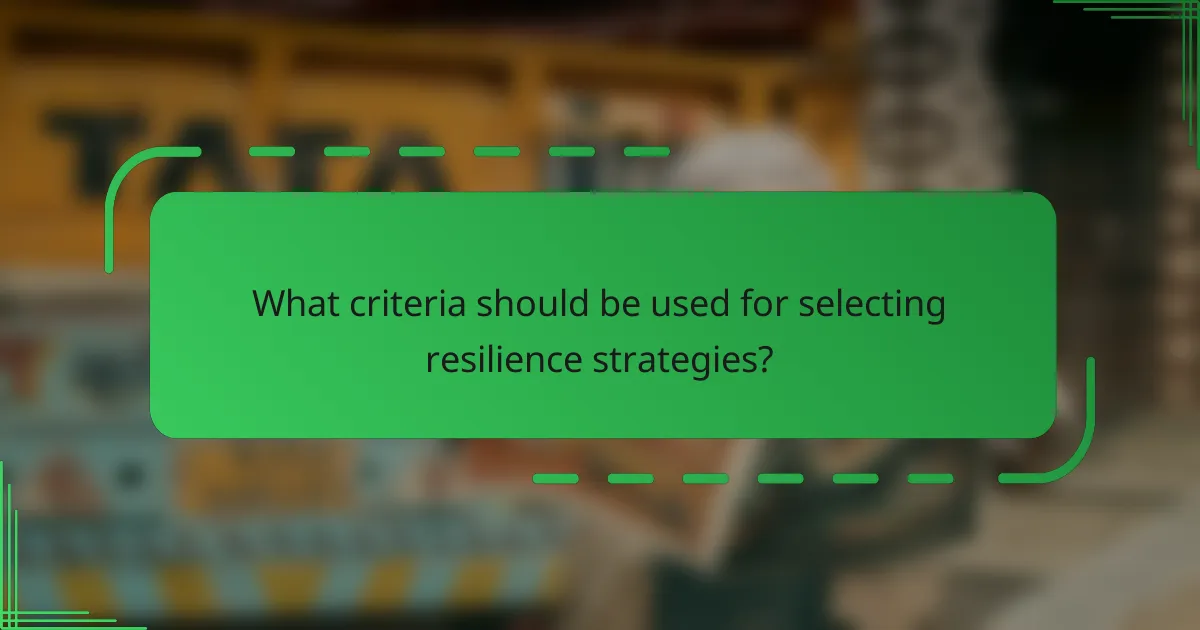
What criteria should be used for selecting resilience strategies?
Selecting resilience strategies involves evaluating their effectiveness, feasibility, and sustainability. Key criteria include community needs, available resources, potential impacts, and the ability to adapt to changing circumstances.
Effectiveness of the strategy
Effectiveness refers to how well a strategy can achieve its intended outcomes, such as reducing vulnerability or enhancing recovery. Consider strategies that have been proven successful in similar contexts or that are backed by research. For instance, community training programs that enhance local skills often yield significant benefits during recovery phases.
Feasibility and resource availability
Feasibility assesses whether a strategy can be realistically implemented given the community’s resources, including financial, human, and technical assets. Evaluate the costs associated with each strategy, such as funding requirements and personnel needs. For example, a community might prioritize low-cost initiatives, like volunteer-led preparedness workshops, over expensive infrastructure projects.
Potential impacts on the community
Consider the broader impacts of resilience strategies on the community, including social, economic, and environmental factors. Strategies should not only address immediate needs but also promote long-term well-being. Engaging community members in the decision-making process can help ensure that chosen strategies align with local values and priorities.
Adaptability to changing circumstances
Resilience strategies should be adaptable to evolving conditions, such as climate change or demographic shifts. This flexibility allows communities to adjust their approaches as new challenges arise. For instance, a strategy that incorporates regular feedback mechanisms can help communities refine their resilience efforts over time, ensuring ongoing relevance and effectiveness.

